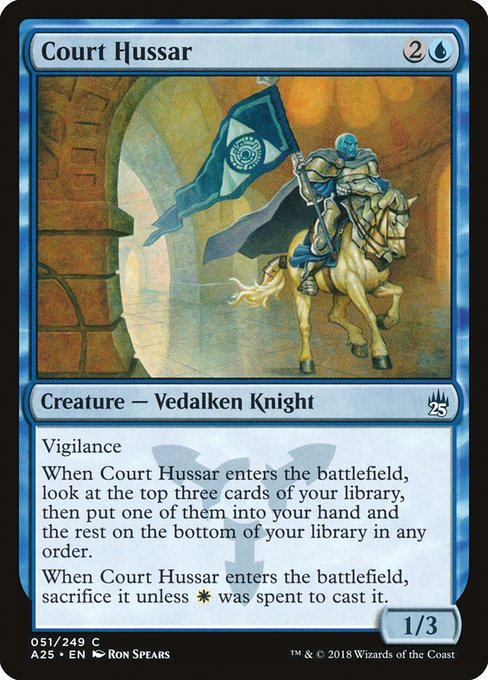
Image courtesy of Scryfall.com
Price watch: Court Hussar across MTG markets
For many players, Court Hussar is a familiar name from the Masters 25 set, a compact blue card with a white twist that shows how MTG markets can diverge by region and platform. This common Vedalken Knight—casting for {2}{U} with vigilance—has a small but telling footprint in card pricing. Its official wording reads: “Vigilance. When this creature enters, look at the top three cards of your library, then put one of them into your hand and the rest on the bottom of your library in any order. When this creature enters, sacrifice it unless {W} was spent to cast it.” It’s a three-mana play that rewards careful sequencing and, in the right deck, a touch of top-deck manipulation. Yet despite its interesting ETB trigger, it remains affordable across many markets, a reminder that print runs and regional demand shape cost just as much as power level. 🧙♂️🔥
When you compare markets—TCGplayer in the US, Cardmarket in Europe, or regional vendors in Asia Pacific—the outcomes can look very different. Court Hussar is a common in Masters 25, but that rarity label doesn’t translate to identical prices from country to country. In the U.S. market, you’ll typically see non-foil copies hovering around the $0.09–$0.15 range, with foil versions closer to $0.15–$0.25 depending on condition and seller. In euros, the euro-equivalent often lands in the same general ballpark, yet shipping, VAT handling, and currency exchange can push the total cost noticeably higher. The card’s color identity (U/W) and the dual-utility of its ability—card selection via the top three plus vigilance—keep it relevant in casual Modern and Commander circles, even if it’s not a flagship Modern staple. 💎⚔️
One practical takeaway for price-conscious players is to separate “paper price” from “ship-to-me price.” Card availability on Cardmarket often reflects a higher volume of European collectors, sometimes yielding slightly more favorable non-foil prices for bulk buys, while TCGplayer and its partner networks can offer faster shipping and robust buyer protections but at a premium for expedited handling. The Masters 25 reprint also influences stock turnover; collectors chasing a Master-set vibe may snag a foil more for display value than actual play—yet even foils stay budget-friendly for this card, emphasizing the broad accessibility of Commander-friendly staples in this cycle. 🧙♂️🎨
Beyond the raw numbers, the card’s ETB aura and the cost-swinging white mana requirement to keep it in play add a flavorful layer to deck design. In ramps or tempo-oriented U/W builds, Court Hussar can be a gentle provoker—drawing you a card while threatening to exit the battlefield unless you’ve spent white mana to cast it. The vigilance helps it dodge some early attack pressure, while its enter-the-battlefield effect can thin the top of your library to smooth future draws. It’s not the flashiest piece, but its design embodies the elegance of balance that MTG design teams chase: utility that scales with how you pay for it. And yes, it’s totally the kind of card a dedicated budget player can build around without breaking the bank. 🧙♂️🧩
For collectors who embrace modern pricing narratives, Court Hussar demonstrates how reprint sets can reset expectations. Masters 25 was a notable collection in the Masters series, and the Masters 25 print is widely available in both foil and nonfoil. If you’re chasing a near-term price dip to pick up several copies for a pep-talk-against-budget-club deck, keep an eye on currency shifts and shipping windows that can nudge the total cost upward. Conversely, if you’re evaluating long-term value, this card’s steady playability in Cube, EDH, and casual formats bodes well for resilience—even at modest price levels. 💎🧭
Market-savvy tips for Court Hussar owners
- Compare base prices, not just listing stars: Look at non-foil versus foil, and track both USD and EUR listings to gauge where savings are real versus where you’re paying for convenience.
- Factor shipping and tax into your total: A bargain card can become a poor deal if shipping to your region inflates the price or triggers import taxes.
- Watch the market tempo: Masters-era reprints tend to cycle as sets rotate and as Commander players seek cheap augmentations for budget decks.
- Consider condition and format: In Modern-legal or Commander formats, mint or near-mint copies fetch relatively higher resale value, but even those are approachable for committed budget-builders.
- Pair with a desk upgrade: If you’re into the aesthetic of MTG on your desk, a neon desk pad can be a playful premium add-on—putting a splash of color on your battlefield while you shuffle for turn one. 🧙♂️🎲
Curious readers who want to explore more angles on card markets can check out related discussions on typography in MTG card layouts, when to mulligan in certain archetypes, and the economics of arcade-style rewards in digital markets. The five linked pieces below bring different lenses—layout analysis, mulligan timing, arcade economy, packaging for digital goods, and the cultural impact of un-card design—into a cohesive reading list for players who love the details as much as the games. 🧠🔥
Custom Neon Desk Mouse Pad 9.3x7.8 in